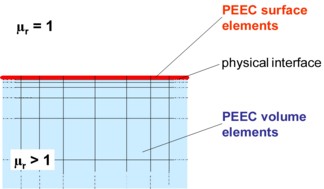The Amperian currents model in the PEEC circuit
Introduction
It is necessary to translate the modeling by Amperian currents into equivalent circuits to complete the consideration of ferromagnetic materials in the PEEC approach.
This translation is described below.
Principle
The translation of the Amperian currents model into the PEEC approach consists in carefully adding the contributions of the artificial currents, both of volume and surface type, to the equivalent R-L-M diagram.
Volume currents contribution
As the PEEC approach requires that the current be unidirectional in each elementary portion of the conductor, and due to the fact that the artificial volume currents and the electric conduction currents have the same direction, the equivalent R-L-M diagram is always valid, provided that the formulas for the calculation of these parameters be carefully modified.
Particularly:
- the partial resistance is not impacted by the artificial volume current, as this current does not contribute to the macroscopic electric conduction;
- the partial inductances (self and mutual) due to ferromagnetic conductors must be
multiplied by the relative permeability µr, to take into consideration the
increase of the magnetic vector potential due to the artificial current:

where
 is the magnetic vector potential created by an
identical conductor, but of µ0 permeability.
is the magnetic vector potential created by an
identical conductor, but of µ0 permeability.
It has to be noticed that only the mutual inductances corresponding to the currents circulating in the magnetic conductors must be multiplied by µr.
Conversely, as the mutual inductances corresponding to the currents circulating in non-magnetic conductors have an effect on the magnetic conductors, they must not be modified. Consequently, the inductances matrix remains square, but not necessarily symmetrical.
Surface currents contribution
Considering the surface artificial currents though requires the addition of supplementary subdivisions to the PEEC mesh, as the paths of the surface artificial currents are not known beforehand.
These subdivisions are of null thickness as they represent surface artificial currents, and they are present only on the external faces of magnetic conductor. The figure below illustrates this principle.

The PEEC model of a surface element consists in an equivalent controlled current generator having the following characteristics:
- the quantities that control the generator are the currents circulating in the
partial inductances of the PEEC volume elements. Indeed this generator must
contribute to close of the artificial volume currents
 ;
; - the control coefficients are connected to the geometry of the PEEC subdivisions. As the mathematic process for the calculation is rather complex, it is not detailed in this document;
- the equivalent generator is connected in parallel to the PEEC model of the adjacent volume subdivision.